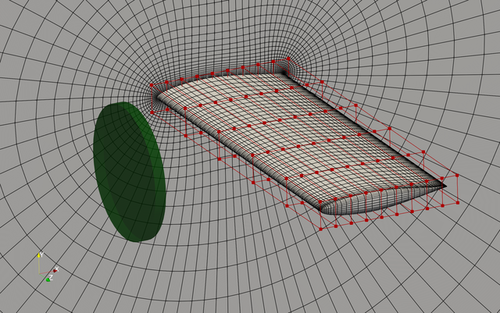The following is an aerodynamic shape optimization case for the Prowim wing-propeller configuration. Refer to this paper for more simulations and optimization results.
Case: Wing-propeller aerodynamic optimization Geometry: Prowim wing Objective function: Drag Design variables: 120 FFD points moving in the y direction Constraints: Volume, thickness, and lift Propeller model: Actuator disk Mach number: 0.3 Mesh cells: 190 K Adjoint solver: DARhoSimpleFoam

Fig. 1. Mesh and FFD points for the Prowim wing-propeller case
To run this case, first download tutorials and untar it. Then go to tutorials-master/Prowim_Wing_Propeller and run the “preProcessing.sh” script to generate the mesh:
./preProcessing.sh
We recommend running this case on an HPC system with 20 CPU cores:
mpirun -np 20 python runScript.py 2>&1 | tee logOpt.txt
This example includes a task to generate a Computer-Aided Design (CAD) file of the optimized wing geometry in IGES format.
This process works by using the original, undeformed geometry in IGES format, and deforming it given the state of the FFD at the end of the optimization.
For this specific example, a script is included to run the deformation, titled deformGeo.sh, but each step of the process can be carried out manually as well.
The process begins with generating the original geometry in IGES format.
This is done using pyGeo and calling the generate_wing.py script in the deformGeo directory to generate an IGES file of the initial geometry.
Also in this directory is the reference data which defines a state of the design variables in the FFD.
This JSON file, OptRef_Example.json, along with the undeformed IGES file must be copied to the root directory of the case.
Then, the geometry can be deformed by running the command:
python runScript.py --task=deformGeo
This task is shown in the code listing below.
The process begins by reading the dictionary of design variable states from the JSON file and then initializing a pyGeo object using the undeformed IGES file in the root directory.
Next, the design variables governing the FFD are updated using the design variable dictionary and the pyGeo method DVGeo.updatePyGeo().
Finally, the geometry is deformed and output to a new IGES file with the name wingNew.igs by calling the pyGeo method DVGeo.updatePyGeo().
elif args.task == "deformGeo":
# Import Optimization Values Dictionary
with open("./OptRef_Example.json") as f:
optRef = json.load(f)
# Import IGES file as geometry object
geo = pyGeo(fileName="./wing.igs", initType="iges")
geo.doConnectivity()
# Update Design Variables
DVGeo.setDesignVars(optRef)
# Deform Geometry and Output
DVGeo.updatePyGeo(geo, "iges", "wingNew", nRefU=10, nRefV=10)
When using this function, it is important to provide an initial geometry that exactly matches the initial geometry used in the optimization.
Additionally, the quality of the deformation and it’s representation of the optimized geometry will greatly depend on how refined its surfaces are; if the output geometry does not match the optimized geometry, provide a more refined initial geometry or increase the values of the parameters nRefU and nRefV.